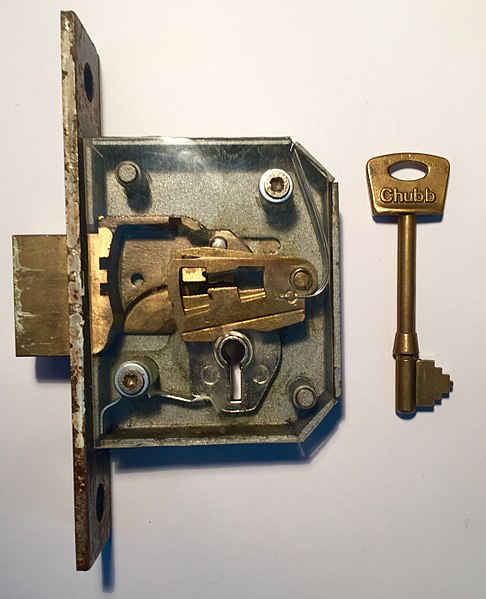Mortice lock

|
| A common lever-type mortice lock in the UK. |
Contents |
[edit] Introduction
A mortice lock (or mortise lock) is a lock that is carved or cut into a pocket on the side of a door or piece of furniture. This type of lock is sometimes used as a second lock for increased security and is commonly found in residential applications.
[edit] History
The mortice lock was commonly used in older buildings in the United States. Two of the country’s early presidents, Thomas Jefferson and James Madison both mentioned mortise locks as their security devices of choice. In 1788, Thomas Jefferson wrote to John Trumbull to request “mortise locks” on a carriage he wanted made to his specifications.
In 1798, James Madison included a reference to the devices (“mortise locks which I accordingly prefer”) in a letter to Jefferson. The letter followed with a review of matters of state. The discussion of locks came before the discussion of politics.
[edit] Operation
The locking body of a mortice lock is installed in the door, piece of furniture or other object while the box keep is installed in the facing frame. The mortice lock works by projecting its locking device (or lever) into the corresponding space on the facing side of the door frame or other object. A key is often used to operate the bolting mechanism and move it into the locked or unlocked position.
Mortice locks can create a layer of security on top of that which has been provided by standard cylindrical locks. Commonly available in deadlock and sashlock varieties, mortice locks are used in residential and commercial properties throughout the United States and Europe.
NB Code of practice: Hardware for fire and escape doors, Issue 5, published by DHF and GAI in November 2024, defines a deadlock as a: ‘Lock that contains only a deadbolt.’ Where a deadbolt is a: ‘Bolt that is operated in both directions by a key, handle and/or thumb turn.’
[edit] Related articles on Designing Buildings
Featured articles and news
RTPI leader to become new CIOB Chief Executive Officer
Dr Victoria Hills MRTPI, FICE to take over after Caroline Gumble’s departure.
Social and affordable housing, a long term plan for delivery
The “Delivering a Decade of Renewal for Social and Affordable Housing” strategy sets out future path.
A change to adoptive architecture
Effects of global weather warming on architectural detailing, material choice and human interaction.
The proposed publicly owned and backed subsidiary of Homes England, to facilitate new homes.
How big is the problem and what can we do to mitigate the effects?
Overheating guidance and tools for building designers
A number of cool guides to help with the heat.
The UK's Modern Industrial Strategy: A 10 year plan
Previous consultation criticism, current key elements and general support with some persisting reservations.
Building Safety Regulator reforms
New roles, new staff and a new fast track service pave the way for a single construction regulator.
Architectural Technologist CPDs and Communications
CIAT CPD… and how you can do it!
Cooling centres and cool spaces
Managing extreme heat in cities by directing the public to places for heat stress relief and water sources.
Winter gardens: A brief history and warm variations
Extending the season with glass in different forms and terms.
Restoring Great Yarmouth's Winter Gardens
Transforming one of the least sustainable constructions imaginable.
Construction Skills Mission Board launch sector drive
Newly formed government and industry collaboration set strategy for recruiting an additional 100,000 construction workers a year.
New Architects Code comes into effect in September 2025
ARB Architects Code of Conduct and Practice available with ongoing consultation regarding guidance.
Welsh Skills Body (Medr) launches ambitious plan
The new skills body brings together funding and regulation of tertiary education and research for the devolved nation.
Paul Gandy FCIOB announced as next CIOB President
Former Tilbury Douglas CEO takes helm.
UK Infrastructure: A 10 Year Strategy. In brief with reactions
With the National Infrastructure and Service Transformation Authority (NISTA).






















